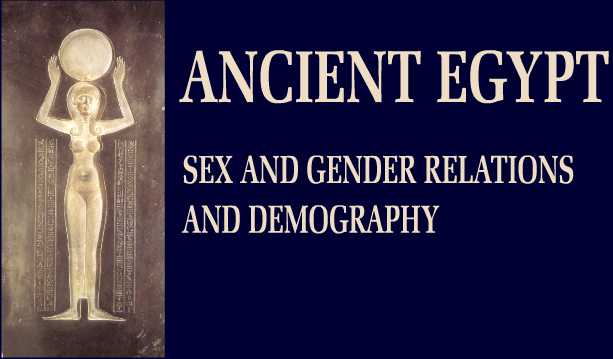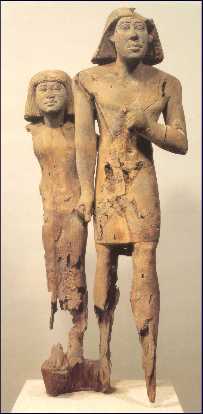 |
|||||||||||||||||||||||||||||||||||||||||||||||||||||||||||||||||||||||||||||
|
Because images and texts most often come from elite sources, until recently most of our knowledge of ancient Egypt reflected a class bias. However, the lives of non-elites can be studied through the study of archaeological evidence, including the remains of dwellings and burials. Information about sex and gender relations can be obtained through studies of dwellings, burials, images, and texts. |
|||||||||||||||||||||||||||||||||||||||||||||||||||||||||||||||||||||||||||||
|
Male
and Female Roles
Both female and male officiants were associated with the cults of female deities, although by far the most common female religious titles relate to the worship of male gods. Although women did hold office, particularly in religious institutions, they were largely excluded from administrative roles. Power is intimately
linked to sex and gender relations, both of which are solidified in
politics and religion. Pharaonic Egypt was ruled by a pharaoh
or "god-king" who ideally passed the succession to his divine
son. Occasionally, a woman would rule independently as pharaoh, Some female titles appear to allude to marital status. A woman was frequently identified by her husband and his occupation but still had considerable theoretical autonomy in legal and economic situations including the legal right to inherit property. This Egyptian tradition persisted even after the introduction of Greek and Roman attitudes and legal traditions, which more heavily restricted women's activities and status. Most literary sources reflect the experiences of elite women and men. Since many of the observable trends in the autonomy of elite women are tied to ownership and property, it is likely that the experience of non-elite women was very different from that of their elite counterparts. Non-elites probably had considerably less autonomy in general. |
|||||||||||||||||||||||||||||||||||||||||||||||||||||||||||||||||||||||||||||
|
Much of our information about ancient Egypt comes from funerary contexts. Throughout his/her life, an individual is exposed to differential life-threatening risks. When an individual succumbs to these risks, his/her age of death is preserved in the archaeological record. It is generally assumed that greater (in number or intensity) risk factors are more likely to result in early death for exposed portions of a population. For example, in populations experiencing high rates of women dying in childbirth, there should be more women than men dying in the childbearing age range. It is impossible to determine a true "life expectancy" in archaeological populations because all individuals are dead, so the average age of death is used as an estimate of life expectancy. The average age at death is also often used as a summary statistic to determine how well adapted segments of a population are to their cultural environments. Use the table below to answer the following questions: |
|||||||||||||||||||||||||||||||||||||||||||||||||||||||||||||||||||||||||||||
|
|||||||||||||||||||||||||||||||||||||||||||||||||||||||||||||||||||||||||||||
|
1. What was the average age at death for each time period. In order to answer this question, combine male and female data and use the median for each age range. For example, the median for the 0-4 year category is 2. (How to calculate the average age of death) 2. Which time period had the highest average age at death (life expectancy)? 3. What was the average age of death for women and men in each time period? 4. Does it appear that women's health is related to changes in women's societal roles during any of the time periods? 5. Was death in childbirth a threat experienced by populations from any of the time periods? In order to answer this question, determine the number of females in all age categories over 15 and divide that number by the total number of females. Then divide the number of males in these age categories by the total number of males, and compare the results. |
|||||||||||||||||||||||||||||||||||||||||||||||||||||||||||||||||||||||||||||
| * All of the art depicted on this page is in the Louvre. Images were modified from Le Louvre: Les Antiquiteés Épyptians, 1993. Edited by C.Ziegler, Scala, Paris. | |||||||||||||||||||||||||||||||||||||||||||||||||||||||||||||||||||||||||||||
 Women's
access to power varied over time. In general, men were in charge
of temples and temple administration, but in the Pharaonic period women
filled a variety of religious offices, especially as priestesses associated
with the cults of such goddesses as Hathor. By the New Kingdom,the priesthood
had become part of the state bureaucracy, which excluded women. At this
time there was an increase in the number of elite women associated with
temples as "musicians" of a particular deity. In the Graeco-Roman
period, women again served in priestly roles but with the rise of Christianity
in Egypt, they were once more excluded from formal religious office.
Women's
access to power varied over time. In general, men were in charge
of temples and temple administration, but in the Pharaonic period women
filled a variety of religious offices, especially as priestesses associated
with the cults of such goddesses as Hathor. By the New Kingdom,the priesthood
had become part of the state bureaucracy, which excluded women. At this
time there was an increase in the number of elite women associated with
temples as "musicians" of a particular deity. In the Graeco-Roman
period, women again served in priestly roles but with the rise of Christianity
in Egypt, they were once more excluded from formal religious office.
 but
this happened rarely, most often in times of uncertainty over succession.
The best-known examples are Hatshepsut from the 18th Dynasty, shown
here on the left, and Cleopatra VII from the Ptolemaic period.
but
this happened rarely, most often in times of uncertainty over succession.
The best-known examples are Hatshepsut from the 18th Dynasty, shown
here on the left, and Cleopatra VII from the Ptolemaic period.
 Mortality
Mortality